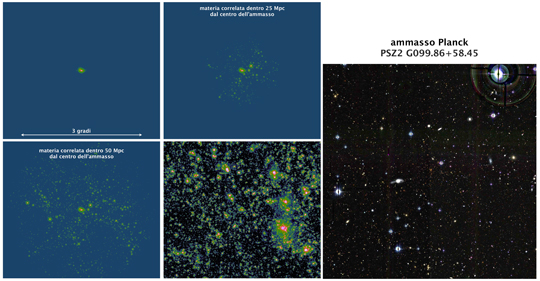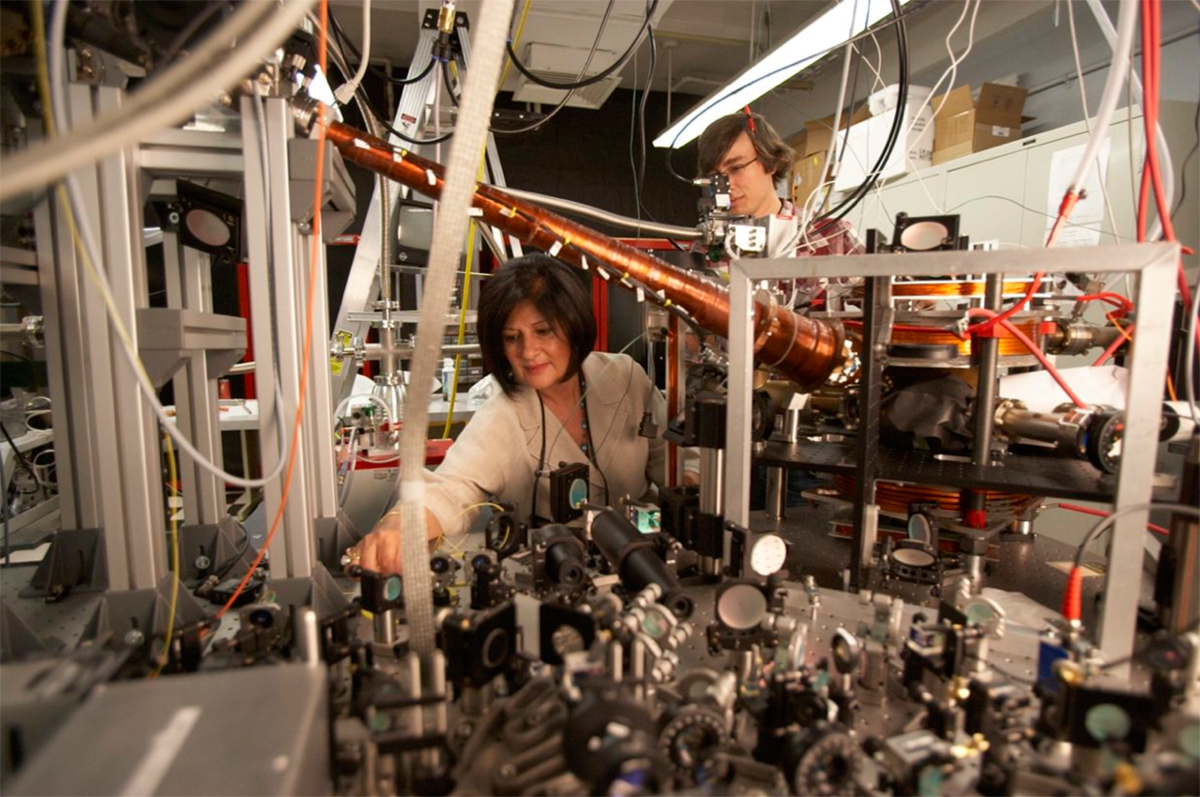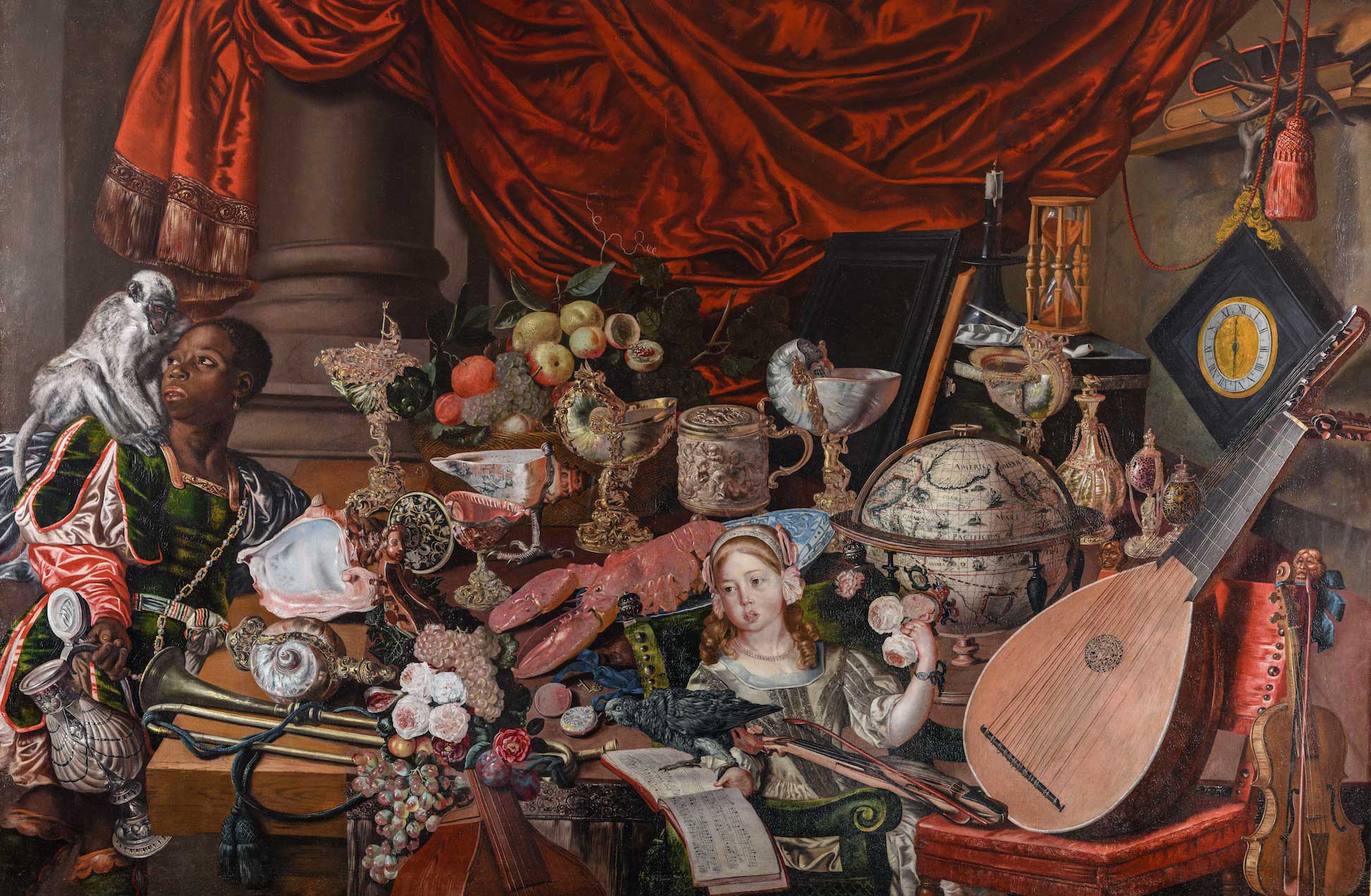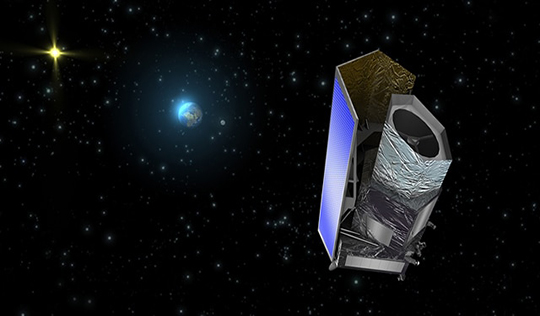ONE OF THE DENSEST COSMIC CLUMPS IN THE UNIVERSE OBSERVED
 UNIBO-INAF-INFN. An international research group, including scientists from INFN, the National Institute of Astrophysics (INAF) and the University of Bologna, has succeeded in locating one of the densest cosmic clumps in the known universe. It is the cosmic environment around the galaxy cluster known as PSZ2 G099.86+58.45. The system has a density of matter around six times greater than the average of other observed clusters. The researchers measured the distribution of mass around the cluster up to a distance of 30 megaparsecs, in other words 6000 billion times the average distance between the Earth and the Sun. Studying this “cosmic web” is particularly complicated because there are fundamental components of the universe, dark matter and dark energy, whose properties we know nothing about. The researchers succeeded in detecting the high density of matter in the cluster because of an effect known as a “gravitational lens”, linked to the capacity of gravity to bend light and so create distortions in the image of celestial objects that we observe. So, in this case, the light generated by the galaxies that lie behind the cluster being studied is bent and amplified by its gravitational field. By analysing the shape of more than 150,000 galaxies, the research group managed to calculate the large concentration of matter around the cluster itself. A large number of numerical simulations led to interpreting the observational analysis of the formation of cosmic structures, which allowed us to quantify that less than 1% of galaxy clusters have such a dense cosmic web. The results of the study have been published in Nature Astronomy.
UNIBO-INAF-INFN. An international research group, including scientists from INFN, the National Institute of Astrophysics (INAF) and the University of Bologna, has succeeded in locating one of the densest cosmic clumps in the known universe. It is the cosmic environment around the galaxy cluster known as PSZ2 G099.86+58.45. The system has a density of matter around six times greater than the average of other observed clusters. The researchers measured the distribution of mass around the cluster up to a distance of 30 megaparsecs, in other words 6000 billion times the average distance between the Earth and the Sun. Studying this “cosmic web” is particularly complicated because there are fundamental components of the universe, dark matter and dark energy, whose properties we know nothing about. The researchers succeeded in detecting the high density of matter in the cluster because of an effect known as a “gravitational lens”, linked to the capacity of gravity to bend light and so create distortions in the image of celestial objects that we observe. So, in this case, the light generated by the galaxies that lie behind the cluster being studied is bent and amplified by its gravitational field. By analysing the shape of more than 150,000 galaxies, the research group managed to calculate the large concentration of matter around the cluster itself. A large number of numerical simulations led to interpreting the observational analysis of the formation of cosmic structures, which allowed us to quantify that less than 1% of galaxy clusters have such a dense cosmic web. The results of the study have been published in Nature Astronomy.
Immagine: Simulazione numerica della distribuzione di materia attorno a un ammasso su diverse scale.




 The leader of the most sensitive dark-matter experiment conducted to date will receive the 2019 Lancelot M. Berkeley – New York Community Trust Prize for Meritorious Work in Astronomy. The Berkeley prize is bestowed annually since 2011 by the American Astronomical Society (AAS) and supported by a grant from the New York Community Trust. Elena Aprile will give her prize lecture on Thursday afternoon, 10 January 2019, during the 233rd AAS meeting at the Washington State Convention & Trade Center in downtown Seattle. Elena Aprile, Professor of Physics at Columbia University in New York City, is being honored with the 2019 Berkeley prize for her leadership of the XENON project and its groundbreaking search for the weakly interacting massive particles (“WIMPs”) thought to make up the mysterious dark matter that appears to provide most of the universe’s gravitational pull. With its multiton liquid-xenon detector, XENON1T - at the Gran Sasso National Laboratory, LNGS in Italy, which is operated by the INFN - is currently the world’s most sensitive direct experimental search for dark matter. Aprile and her colleagues are narrowing the range of allowable particle masses and interaction strengths. WIMPs have almost nowhere left to hide, causing physicists and astronomers to rethink the nature of dark matter and to wonder if the particles might be much less massive than originally thought. Elena Aprile founded the XENON Dark Matter Collaboration in 2002 and has served as its scientific spokesperson ever since; her international team includes more than 165 scientists and students representing 24 nationalities and 21 institutions.
The leader of the most sensitive dark-matter experiment conducted to date will receive the 2019 Lancelot M. Berkeley – New York Community Trust Prize for Meritorious Work in Astronomy. The Berkeley prize is bestowed annually since 2011 by the American Astronomical Society (AAS) and supported by a grant from the New York Community Trust. Elena Aprile will give her prize lecture on Thursday afternoon, 10 January 2019, during the 233rd AAS meeting at the Washington State Convention & Trade Center in downtown Seattle. Elena Aprile, Professor of Physics at Columbia University in New York City, is being honored with the 2019 Berkeley prize for her leadership of the XENON project and its groundbreaking search for the weakly interacting massive particles (“WIMPs”) thought to make up the mysterious dark matter that appears to provide most of the universe’s gravitational pull. With its multiton liquid-xenon detector, XENON1T - at the Gran Sasso National Laboratory, LNGS in Italy, which is operated by the INFN - is currently the world’s most sensitive direct experimental search for dark matter. Aprile and her colleagues are narrowing the range of allowable particle masses and interaction strengths. WIMPs have almost nowhere left to hide, causing physicists and astronomers to rethink the nature of dark matter and to wonder if the particles might be much less massive than originally thought. Elena Aprile founded the XENON Dark Matter Collaboration in 2002 and has served as its scientific spokesperson ever since; her international team includes more than 165 scientists and students representing 24 nationalities and 21 institutions. Hidden in a painting for almost four centuries and visible for the first time in an image obtained with a special mobile scanner called LANDIS-X created by researchers of the Italian National Institute for Nuclear Physics (INFN) and National Council for Research (CNR). We are speaking of a female figure painted and then covered, probably a member of the family depicted in the painting “The Paston Treasure”, an important painting of English art history commissioned by Sir William Paston to an itinerant Flemish painter in the seventeenth century. An exhibition dedicated to the painting will open on 23 June next at the
Hidden in a painting for almost four centuries and visible for the first time in an image obtained with a special mobile scanner called LANDIS-X created by researchers of the Italian National Institute for Nuclear Physics (INFN) and National Council for Research (CNR). We are speaking of a female figure painted and then covered, probably a member of the family depicted in the painting “The Paston Treasure”, an important painting of English art history commissioned by Sir William Paston to an itinerant Flemish painter in the seventeenth century. An exhibition dedicated to the painting will open on 23 June next at the  The 9th edition of the Erice International School of Science Journalism (EISSJ) started today, June 25 . The school offers every year 35 scholarships to young science journalists and communicators. The 2018 edition focuses on the theme "What’s Next: Challenges and Opportunities for Tomorrow’s Fundamental Physics". It is taking place between June 25 to 29 in Erice, the evocative town that hosts the Ettore Majorana Centre for Science Culture.
The 9th edition of the Erice International School of Science Journalism (EISSJ) started today, June 25 . The school offers every year 35 scholarships to young science journalists and communicators. The 2018 edition focuses on the theme "What’s Next: Challenges and Opportunities for Tomorrow’s Fundamental Physics". It is taking place between June 25 to 29 in Erice, the evocative town that hosts the Ettore Majorana Centre for Science Culture. On 14 June in the ThalesAlenia Space facility in Turin, the avionic model (AVM) of the Near Infrared Spectro Photometer (NISP) was delivered, the “eye” in the infrared, which will join the one in the visible (VIS) in helping the Euclid space mission of the European Space Agency (ESA) to study the Dark Universe with levels of precision never reached before. The aim of Euclid is to create a super-detailed map of the distribution and the evolution of dark matter and dark energy in the Universe. AVM is the first fully functioning system of the electronic part of the “infrared eye” NISP and it makes it possible to check that the instrument is working properly, starting from commands sent from Earth, down to receiving scientific data, after processing by the on-board computer and by the two software systems. The AVM is completely “made in Italy” and Italy, in the guise of the Italian Space Agency (ASI), is involved in the Euclid mission under numerous aspects: both with making the subsystems of the on-board instruments and with responsibility for management of the Earth Segment and the survey, but also with important roles in managing technical and scientific aspects of the mission. More than two hundred Italian scientists are involved in Euclid, coming from the INAF (National Institute of Astrophysics), INFN and several Universities. The avionic model AVM, delivered in mid-June, consists of various instruments. Apart from the series of simulators of the detectors, motors and the thermal control system of the NISP, the system includes two control units, with software created by INAF installed: the Instrument Control Unit (ICU) and the control and management unit of the data from the detectors, the Data Processing Unit (DPU), made by the Italian company OHB and financed by the ASI. The AVM model of NISP was assembled in the INFN laboratories and those of the University of Padua, with the involvement of the whole INAF and INFN team. The subsystems were then tested, thanks to software developed by INFN research groups, with the support of CNAF, the INFN national centre of information and telematics technology. After successful completion of the testing, the ESA has approved the delivery of the first working model to Thales Alenia Space of Turin, who are responsible for producing the Euclid satellite, which will use it for verifying communications between the satellite itself and the NISP instrument. Over two hundred Italian scientists are involved in Euclid, belonging to INAF (the Institutes of IAPS, OAS Bologna and IASF Milan and the Astronomical Observatories of Bologna, Brera, Padua, Rome, Turin and Trieste), to the National Institute of Nuclear Physics (sections of Bologna, Padua, Lecce, Milan and Rome1) and to a number of Universities (University of Bologna, University of Ferrara, La Sapienza of Rome, Roma Tre University, University of Tor Vergata, University of Trieste, SISSA of Parma and the CISAS of the University of Padua).
On 14 June in the ThalesAlenia Space facility in Turin, the avionic model (AVM) of the Near Infrared Spectro Photometer (NISP) was delivered, the “eye” in the infrared, which will join the one in the visible (VIS) in helping the Euclid space mission of the European Space Agency (ESA) to study the Dark Universe with levels of precision never reached before. The aim of Euclid is to create a super-detailed map of the distribution and the evolution of dark matter and dark energy in the Universe. AVM is the first fully functioning system of the electronic part of the “infrared eye” NISP and it makes it possible to check that the instrument is working properly, starting from commands sent from Earth, down to receiving scientific data, after processing by the on-board computer and by the two software systems. The AVM is completely “made in Italy” and Italy, in the guise of the Italian Space Agency (ASI), is involved in the Euclid mission under numerous aspects: both with making the subsystems of the on-board instruments and with responsibility for management of the Earth Segment and the survey, but also with important roles in managing technical and scientific aspects of the mission. More than two hundred Italian scientists are involved in Euclid, coming from the INAF (National Institute of Astrophysics), INFN and several Universities. The avionic model AVM, delivered in mid-June, consists of various instruments. Apart from the series of simulators of the detectors, motors and the thermal control system of the NISP, the system includes two control units, with software created by INAF installed: the Instrument Control Unit (ICU) and the control and management unit of the data from the detectors, the Data Processing Unit (DPU), made by the Italian company OHB and financed by the ASI. The AVM model of NISP was assembled in the INFN laboratories and those of the University of Padua, with the involvement of the whole INAF and INFN team. The subsystems were then tested, thanks to software developed by INFN research groups, with the support of CNAF, the INFN national centre of information and telematics technology. After successful completion of the testing, the ESA has approved the delivery of the first working model to Thales Alenia Space of Turin, who are responsible for producing the Euclid satellite, which will use it for verifying communications between the satellite itself and the NISP instrument. Over two hundred Italian scientists are involved in Euclid, belonging to INAF (the Institutes of IAPS, OAS Bologna and IASF Milan and the Astronomical Observatories of Bologna, Brera, Padua, Rome, Turin and Trieste), to the National Institute of Nuclear Physics (sections of Bologna, Padua, Lecce, Milan and Rome1) and to a number of Universities (University of Bologna, University of Ferrara, La Sapienza of Rome, Roma Tre University, University of Tor Vergata, University of Trieste, SISSA of Parma and the CISAS of the University of Padua).

